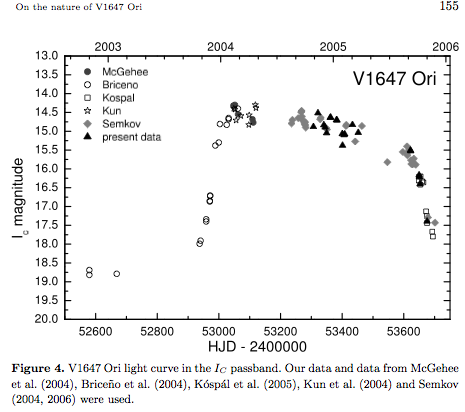Difference between revisions of "Triggers:FUOri"
From Gaia Science Alerts Working Group
Jump to navigationJump to search| Line 1: | Line 1: | ||
| + | == FU Orionis (FUors) == | ||
FU Orionis (V1647 Ori) is young pre-main sequence stars, illuminating a McNeil's nebula in the vicinity of NGC 2068 star-forming region. | FU Orionis (V1647 Ori) is young pre-main sequence stars, illuminating a McNeil's nebula in the vicinity of NGC 2068 star-forming region. | ||
| Line 10: | Line 11: | ||
* Amplitude: 5 mag over 4 months | * Amplitude: 5 mag over 4 months | ||
* Outbursts last for 2 years | * Outbursts last for 2 years | ||
| + | * Spectra: F or G supergiants | ||
* Spectrum: red, heavily veiled continuum with strong emission of <math>H_{\alpha}</math>; in blue consistent with an early B spectral type | * Spectrum: red, heavily veiled continuum with strong emission of <math>H_{\alpha}</math>; in blue consistent with an early B spectral type | ||
* X-ray variability present | * X-ray variability present | ||
| + | * FU Ori and V1057 Cyg rise over 1 yr, whereas V1515 Cyg rise over 20 years | ||
| + | * FU Ori and V1515 Cyg decline over 20-100 years, V1015 Cyg decays faster (10 yrs) | ||
| − | + | == Similar types to FU Ori == | |
| + | === EX Lupis (EXors) === | ||
| − | + | === OO Serpentis === | |
| − | + | OO Ser ([http://arxiv.org/abs/0705.1231 Kospal et al. 2007]) is an object discovered with ''Infrared Space Observatory'', similar to FUors and EXors. | |
| − | |||
| − | |||
| − | |||
Revision as of 12:44, 10 July 2009
FU Orionis (FUors)
FU Orionis (V1647 Ori) is young pre-main sequence stars, illuminating a McNeil's nebula in the vicinity of NGC 2068 star-forming region.
 Plot from D.Chochol et al. 2006.
Plot from D.Chochol et al. 2006.
Characteristics:
- Very rare
- Outbursts repeat with a time scale of 40 years (1978, 2003)
- Amplitude: 5 mag over 4 months
- Outbursts last for 2 years
- Spectra: F or G supergiants
- Spectrum: red, heavily veiled continuum with strong emission of <math>H_{\alpha}</math>; in blue consistent with an early B spectral type
- X-ray variability present
- FU Ori and V1057 Cyg rise over 1 yr, whereas V1515 Cyg rise over 20 years
- FU Ori and V1515 Cyg decline over 20-100 years, V1015 Cyg decays faster (10 yrs)
Similar types to FU Ori
EX Lupis (EXors)
OO Serpentis
OO Ser (Kospal et al. 2007) is an object discovered with Infrared Space Observatory, similar to FUors and EXors.